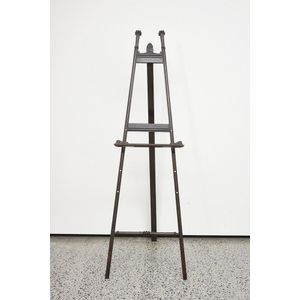Late 19th Century Ebonised Mahogany Easel with Anthemion Cresting
ebonised mahogany easel, late 19th century, of strut form, the uprights with scrolled finials and anthemion cresting, the adjustable rest carved with scrolls, turned stretcher, height 182 cm width 42 cm. provenance: The collection of the late John Schaeffer Ao. Private Collection, Sydney
You must be a subscriber, and be logged in to view price and dealer details.
Subscribe Now to view actual auction price for this item
When you subscribe, you have the option of setting the currency in which to display prices to $Au, $US, $NZ or Stg.
This item has been sold, and the description, image and price are for reference purposes only.
- Finial - An architectural decoration, found on the upper parts of of an object. On furniture they are usually found on pediments, canopies and shelf supports. On smaller ceramic or silver items, such as spoons, they may decorate the top of the item itself, or the lid or cover where they provide a useful handle for removal.
Finials have a variety of shapes and forms. They may be urn-shaped, baluster shaped round or spiral, but usually taper into an upper point. Many real life shapes may also be used as finials, such as pineapples, berries, pinecones, buds, lotus and acorns. Sometimes animals such as a lion are depicted, or fish and dolphins. - Provenance - A term used to describe the provable history of an antique or work of art, and thus an additional aid to verifying its authenticity. Provenance can have an inflating effect on the price of an item, particularly if the provenance relates to the early settlement of Australia, a famous person, or royalty. Less significant are previous sales of the item through an auction house or dealer.
- Scrolls - Serpentine-shaped forms, used in cabinet construction and decoration for centuries. The scroll appears in legs, feet, as carving in chair brackets, chair rails and arms. The deeper and more spontaneous the carving is, the earlier the piece is likely to be. The Regency or 'Thomas Hope' scroll, used on pediments and sideboard backs, consists of two scrolls on the horizontal plane, placed back to back in a mirror image, and sometimes decorated with a variety of carved and/or applied ornament, such as shells, foliate and other motifs. Chippendale-style furniture is often distinguished by two corresponding scrolls in the form of a 'C' in the upper splat or where chair legs join the seat rail.
- Turning - Any part of a piece of furniture that has been turned and shaped with chisels on a lathe. Turned sections include legs, columns, feet, finials, pedestals, stretchers, spindles etc. There have been many varieties and fashions over the centuries: baluster, melon, barley-sugar, bobbin, cotton-reel, rope-twist, and so on. Split turning implies a turned section that has been cut in half lengthwise and applied to a cabinet front as a false decorative support.
- Ebonised - Timber that has been stained or lacquered black in imitation of ebony. The process has been used since the Renaissance, but is most commonly found in late 19th century furniture, sometimes gilded and turned in imitation of bamboo. Furniture with an ebonised finish is not currently in vogue, and this is reflected in the price for such pieces.
- Cresting - The decorative carving at the top of a piece of furniture, such as a sideboard back, a mirror, or a chair back.
- Anthemion - An anthemion is a classical decorative design element based on the acanthus flower that consists of a central circular or oval motif surrounded by radiating petals or leaves. It is often used as a border or frieze in architecture, furniture, and other decorative arts. The anthemion is derived from the palmette, a motif that was popular in ancient Greek and Roman art and architecture. It is often associated with the classical world and with Neoclassical style, and it is often used to add a sense of grandeur and formality to a design. The anthemion is also known as a honeysuckle or honeysuckle ornament. It continues to be used in a variety of contexts today, and it is often admired for its elegant and decorative qualities.
- Stretcher - A horizontal rail which connects the legs of stools, chairs, tables and stands, to provide stabilisation of the legs. A stretcher table is any table with a stretcher base. The term is usually applied to substantial farmhouse tables, although many cabinetmaker's pieces, such as sofa tables, also have turned stretchers.
- Mahogany - Mahogany is a dense, close grained red-coloured timber from the West Indies and Central America. It was first imported into Europe in the the early 18th century and its use continued through the 19th century. It was popular for furniture making because of its strength, the wide boards available, the distinctive grain on some boards, termed flame mahogany and the rich warm colour of the timber when it was polished.. The "flame" was produced where a limb grew out from the trunk of the tree, and this timber was usually sliced into veneers for feature panels on doors, backs and cornices.
Some terms used to describe mahogany relate to the country from which it originally came, such as "Cuban" mahogany, "Honduras" mahogany etc. However unless the wood has been tested the names assigned are more a selling feature, rather than a true indication of the timber's origin.
This item has been included into following indexes:
